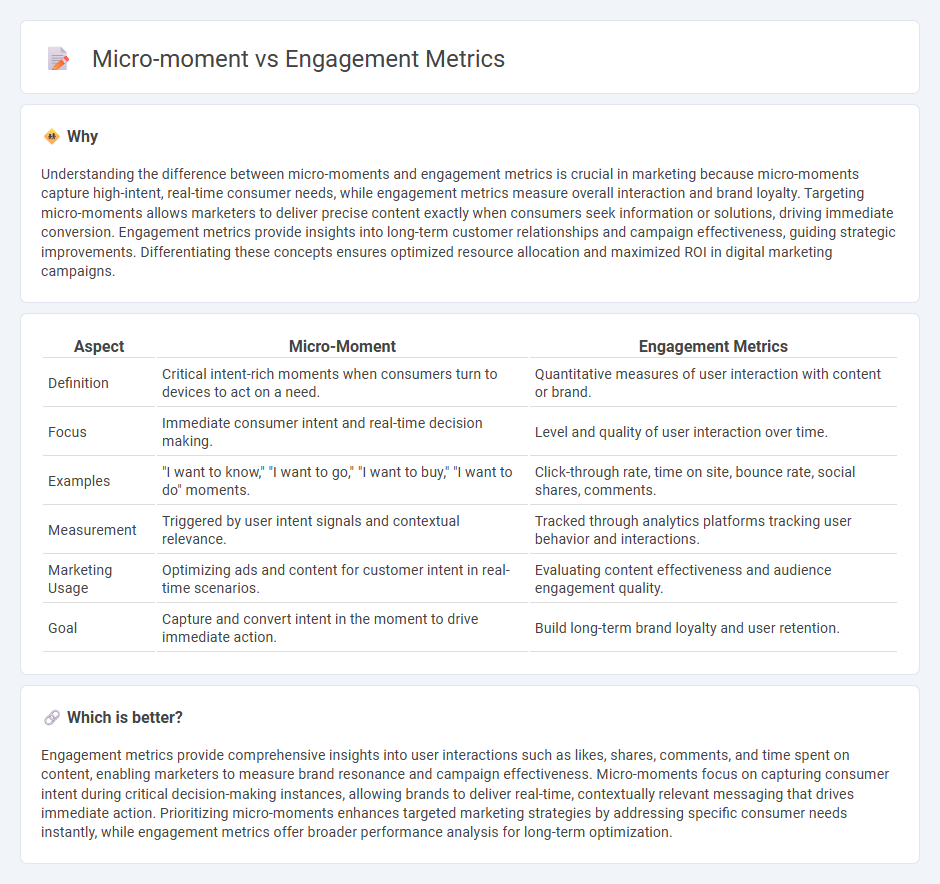
Micro-moments represent critical instances when consumers turn to devices for quick answers, driving real-time decision-making and influencing purchasing behavior. Engagement metrics measure user interactions such as clicks, likes, shares, and time spent, offering insights into how content resonates with the audience. Explore how leveraging micro-moments can elevate your engagement metrics and boost marketing effectiveness.
Why it is important
Understanding the difference between micro-moments and engagement metrics is crucial in marketing because micro-moments capture high-intent, real-time consumer needs, while engagement metrics measure overall interaction and brand loyalty. Targeting micro-moments allows marketers to deliver precise content exactly when consumers seek information or solutions, driving immediate conversion. Engagement metrics provide insights into long-term customer relationships and campaign effectiveness, guiding strategic improvements. Differentiating these concepts ensures optimized resource allocation and maximized ROI in digital marketing campaigns.
Comparison Table
| Aspect | Micro-Moment | Engagement Metrics |
|---|---|---|
| Definition | Critical intent-rich moments when consumers turn to devices to act on a need. | Quantitative measures of user interaction with content or brand. |
| Focus | Immediate consumer intent and real-time decision making. | Level and quality of user interaction over time. |
| Examples | "I want to know," "I want to go," "I want to buy," "I want to do" moments. | Click-through rate, time on site, bounce rate, social shares, comments. |
| Measurement | Triggered by user intent signals and contextual relevance. | Tracked through analytics platforms tracking user behavior and interactions. |
| Marketing Usage | Optimizing ads and content for customer intent in real-time scenarios. | Evaluating content effectiveness and audience engagement quality. |
| Goal | Capture and convert intent in the moment to drive immediate action. | Build long-term brand loyalty and user retention. |
Which is better?
Engagement metrics provide comprehensive insights into user interactions such as likes, shares, comments, and time spent on content, enabling marketers to measure brand resonance and campaign effectiveness. Micro-moments focus on capturing consumer intent during critical decision-making instances, allowing brands to deliver real-time, contextually relevant messaging that drives immediate action. Prioritizing micro-moments enhances targeted marketing strategies by addressing specific consumer needs instantly, while engagement metrics offer broader performance analysis for long-term optimization.
Connection
Micro-moments represent critical touchpoints when consumers turn to their devices for quick decision-making, making engagement metrics essential for tracking user interactions in these instances. High engagement rates during micro-moments indicate effective content delivery and relevance, directly impacting conversion rates and customer satisfaction. Analyzing metrics like click-through rate, session duration, and bounce rate during these micro-moments helps marketers optimize strategies for real-time user needs.
Key Terms
**Engagement Metrics:**
Engagement metrics such as click-through rates, time spent on page, and social shares provide quantifiable insights into user interaction with digital content, helping marketers measure the effectiveness of campaigns and user interest levels. These metrics are crucial for understanding behavioral patterns during micro-moments, which are brief instances when users turn to their devices for immediate information or decision-making. Explore how optimizing engagement metrics can enhance your strategy for capturing valuable micro-moments.
Click-Through Rate (CTR)
Engagement metrics such as Click-Through Rate (CTR) directly measure user interactions with content, reflecting the effectiveness of capturing audience interest during micro-moments--brief instances when users seek quick, intent-driven information. High CTR values indicate successful targeting of micro-moments by delivering relevant and compelling calls-to-action that prompt immediate clicks. Explore deeper insights into optimizing CTR for micro-moments performance to boost your digital marketing strategy.
Time on Page
Engagement metrics such as Time on Page provide crucial insights into user interaction by measuring the duration visitors spend on specific content, reflecting content relevance and user interest. Micro-moments capture intent-driven, real-time behavior that often results in brief, focused interactions, making Time on Page a key metric to differentiate between fleeting attention and deeper engagement. Explore more to understand how optimizing Time on Page enhances user experience and content strategy within micro-moments.
Source and External Links
Top 10 customer engagement metrics to measure in 2025 - Zendesk - Tracks key indicators such as conversion rate, pages per session, Net Promoter Score, and average session duration to assess how effectively users interact with campaigns and content.
11 Important User Engagement Metrics for You To Track | Indeed.com - Measures user interaction through metrics like page views, session duration, bounce rate, and retention rate to evaluate content reach and effectiveness.
9 Key Metrics & KPIs to Measure Customer Engagement - Focuses on product usage with metrics such as monthly active users, feature usage, conversion rate, and Net Promoter Score (NPS) to gauge customer interaction and satisfaction.
 dowidth.com
dowidth.com